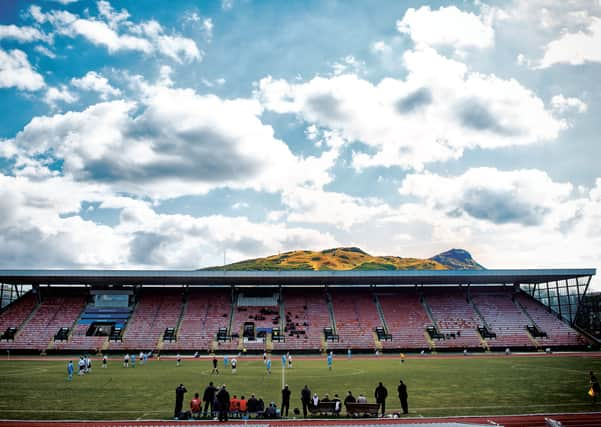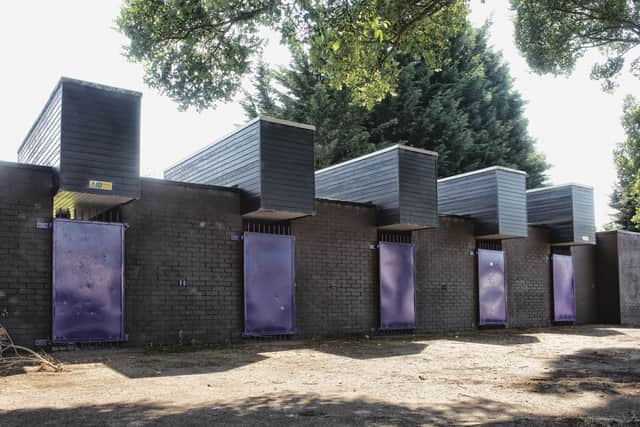Ode to Meadowbank, a great clump of beautiful Brutalism


“It was one of the worst places that you could play football”, says Terry Christie, legendary Meadowbank Thistle manager, when asked about his team’s home ground. “That was greatly to our advantage because everybody hated going there. You were distant from the pitch. There was a wind tunnel which came along from Princes Street and down Regent Road and into the stadium, and there was always a gale blowing from west to east that we used to our advantage.”
Christie casts these damnations from beneath eyes that beam and twinkle. At this curio of a stadium occurred his greatest footballing days. On that furrowed green noosed by a running track, goals were scored and matches won. Art is possible even on a faulty canvas. His Thistle team, the forgotten younger brother of Auld Reekie football, won promotion and reached a League Cup semi-final with Meadowbank as their home. In 1988, they finished second in the First Division but were denied access to the Premier Division by a shifting of the deckchairs – ah reconstruction, that old tale with no ending.
Advertisement
Hide AdAdvertisement
Hide AdGenius of a different type to wily Christie’s had previously prettified this turf; in 1971, the Ford Fives European Festival was played here by Matthews and Finney, Puskas and Kubala, and many twinkle-footed more. Inspired, perhaps, Ferranti Thistle moved to the stadium three years later and took Meadowbank as their married name in reverse. This concrete abode was theirs for richer and for poorer. Christie – famed latterly for his duffel coat, as a Beatle was famed for a mop-top or Michael Foot for his donkey jacket – became manager in 1980.


Players rarely loved this place, disliking the music piped into the dressing rooms and their physical separation from supporters by those running lanes. They resented, too, paying 10 pence to use a communal Edinburgh Council locker for their clothes having changed into their kit. This was a shared space: at 2pm it belonged to practicing long-jumpers; at 3pm to the players of Meadowbank and Stenhousemuir or Dumbarton.
“They putt the shot onto the pitch,” remembers Christie, “and things like that even on a Saturday morning, when you’re trying to get a smooth pitch. I would go down and take sand out of the sand pit and fill all the holes. You had athletes running on the pitch up to an hour before our games started. One day, it was going on about 45 minutes before kick-off and I went over to them, big guys, and said ‘You’ve got to stop running.’ I maybe wasn’t as diplomatic as I should have been and a guy told me to go to hell. I uttered some oath, at which point this giant of a guy came over and punched me on the chin. Not long until kick-off and I’m lying out on the ground!”
From the deck, Christie would have seen a main stand not unlike those built in the Soviet world. It was a great clump of municipal Brutalism, starkly beautiful, to these eyes anyway, against the repetitive tenements and forever looming and inescapable hills of Edinburgh.
Sometimes it is good to not really be sure where you are.
This stadium resembled that of a Warsaw or Leipzig team glimpsed while watching the European Cup Winners’ Cup on television. There was the tree-lined exterior that muttered of planned facilities in a Urals New Town. A colossal scoreboard – shipped here, in fact, from the 1984 Los Angeles Olympics – looked more apt for pronouncements of a great leader’s triumphs than proclamations of a goal for St Mirren. Bleached orange seats fading like a holiday tan were each stamped with a number in a font that recalled the cumbersome entrance door to a Cold War bunker; in some other version of history, this could well have been home to a military football club bolstered by its doting and controlling state apparatus. And of course, there was that running track girdling the pitch, a blissfully rare sight in British football, yet one that added to Meadowbank’s oddly alluring air of otherness. Here rested a little pocket of Leningrad tucked behind Arthur’s Seat.
By 2019, though, the wrecking ball was poised like a shotputter’s arm. Pile drivers waited to pock the surface like fattened javelins. Soon, they would wipe this bedraggled oddity from the face of the city, erasing traces of Christie and Thistle, and of the rising Edinburgh City FC, residents here from 1996 until 2017. The plan is that they will move back some day to another Meadowbank, overshadowed now not by a fascinating outlier of a stadium, but by flats. This is modern Edinburgh, where thin walls reign over interesting ones.
When football stands are bulldozed, they collapse slowly and heavily like afternoon drunks.
It is a cruel death. Terraces are difficult to delete. They are stubborn as old dogs and seem to gnarl their teeth at the pneumatic drill. But in the end they fall. Even the floodlights founder, wincing and then crumpling as boxers do. Those of us that know Edinburgh may now pause as we pass Meadowbank and try to imagine a final whistle sounding in the wind.
Advertisement
Hide AdAdvertisement
Hide Ad• From Snapshot: Scenes and Stories from the Heartlands of Scottish Football by Daniel Gray and Alan McCredie, published by Arena Sport in partnership with Nutmeg Magazine (£14.99, paperback)
Comments
Want to join the conversation? Please or to comment on this article.